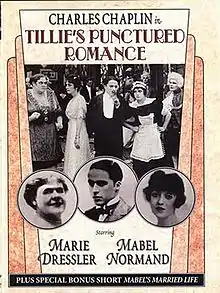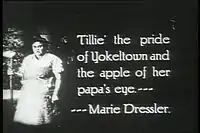Tillie's Punctured Romance (1914 film)
Tillie's Punctured Romance is a 1914 American silent comedy film directed by Mack Sennett and starring Marie Dressler, Mabel Normand, Charlie Chaplin, and the Keystone Kops. The picture was the first feature-length motion picture produced by the Keystone Film Company, and is the only one featuring Chaplin.
| Tillie's Punctured Romance | |
|---|---|
 1999 Image Entertainment DVD | |
| Directed by | Mack Sennett |
| Produced by | Mack Sennett |
| Written by | Hampton Del Ruth Craig Hutchinson Mack Sennett |
| Based on | Tillie's Nightmare by A. Baldwin Sloane and Edgar Smith |
| Starring | Marie Dressler Mabel Normand Charles Chaplin Mack Swain Charles Bennett Chester Conklin The Keystone Cops Charley Chase (uncredited) |
| Cinematography | Hans F. Koenekamp (uncredited) Frank D. Williams (uncredited) |
Production company | |
| Distributed by | Alco Film Corporation[1] |
Release date |
|
Running time | 74 minutes 82 minutes (2003 restoration) |
| Country | United States |
| Language | Silent English intertitles |
The film is based on Dressler's stage play Tillie's Nightmare by A. Baldwin Sloane and Edgar Smith. Tillie's Punctured Romance is notable for being the last Chaplin film which he neither wrote nor directed, as well as the first feature-length comedy in all of cinema. In it, Chaplin plays an entirely different role from his Tramp character, which was relatively new at the time.
Plot
Charles Chaplin portrays a womanizing city man who meets Tillie (Marie Dressler) in the country after a fight with his girlfriend (Mabel Normand). When he sees that Tillie's father (Mack Swain) has a very large bankroll for his workers, he persuades her to elope with him. In the city, he meets the woman he was seeing already, and tries to work around the complication to steal Tillie's money. He gets Tillie drunk in a restaurant and asks her to let him hold the pocketbook. Since she is drunk, she agrees, and he escapes with his old girlfriend and the money.
Later that day, they see a picture show entitled "A Thief's Fate", which illustrates their thievery in the form of a morality play. They both feel guilty and leave the theater. While sitting on a park bench, a paperboy (Gordon Griffith) asks him to buy a newspaper. He does so, and reads the story about Tillie's Uncle Banks (Charles Bennett), a millionaire who died while on a mountain-climbing expedition. Tillie is named sole heir and inherits three million dollars. The man leaves his girlfriend on the park bench and runs to the restaurant, where Tillie is now forced to work to support herself as she is too embarrassed to go home. He begs her to take him back and although she is skeptical at first, she believes that he truly loves her and they marry. They move into the uncle's mansion and throw a big party, which ends horribly when Tillie finds her husband with his old girlfriend, smuggled into the house and working as one of their maids.
The uncle is found on a mountaintop, alive after all. He goes back to his mansion, in disarray after Tillie instigated a gunfight (a direct result of the husband smuggling the old girlfriend into the house) which, luckily, did not harm anyone. Uncle Banks insists that Tillie be arrested for the damage she has caused to his house. The three run from the cops all the way to a dock, where a car "bumps" Tillie into the water. She flails about, hoping to be rescued. She is eventually pulled to safety, and both Tillie and the man's girlfriend realize that they are too good for him. He leaves, and the two girls become friends.
Cast


_-_Ad_2.jpg.webp)
.jpg.webp)
- Marie Dressler ... Tillie Banks, Country Girl
- Mabel Normand .. Mabel, Charlie's Girl Friend
- Charles Chaplin ... Charlie, City Slicker
- Mack Swain ... John Banks, Tillie's Father
- Charles Bennett ... Uncle Banks, Tillie's millionaire uncle
Uncredited
- Dan Albert ... Party Guest/Cop
- Phyllis Allen ... Prison Matron/Restaurant patron
- Billie Bennett ... Maid/Party Guest
- Joe Bordeaux ... Policeman (appearance is not verified)
- Glen Cavender ... First Pianist in Restaurant
- Charley Chase ... Detective in Movie Theater
- Dixie Chene ... Guest
- Nick Cogley ... Keystone Cop Desk Sergeant
- Chester Conklin ... Mr. Whoozis/Singing Waitor
- Alice Davenport ... Guest
- Hampton Del Ruth ... Bank's tall Secretary searching for Tillie
- Frankie Dolan ... Movie Spectator/Party Guest
- Minta Durfee ... Maid[3]
- Ted Edwards ... Waiter
- Edwin Frazee ...Movie Spectator/Guest/Cop
- Billy Gilbert ... Policeman
- Gordon Griffith ... Newsboy
- William Hauber ... Servant/Cop
- Fred Fishback ... Servant
- Alice Howell ...Guest
- Edgar Kennedy ... Restaurant Owner/Butler
- Grover Ligon ... Keystone Cop
- Wallace MacDonald ... Keystone Cop
- Hank Mann ... Keystone Cop
- Harry McCoy ... Second Pianist in Restaurant/Pianist in Theater/Servant
- Rube Miller ... Tillie's Visitor
- Charles Murray ... Detective in "A Thief's Fate"
- Eva Nelson ... Disgusted Guest in 2nd Restaurant
- Edward Nolan ... Restaurant Dancer/Policeman/Mountain Innkeeper/Party Guest
- Frank Opperman ... Rev. D. Simpson
- Hugh Saxon ...Bank's shorter Secretary searching for Tillie
- Fritz Schade ... Waiter/Diner
- Al St. John ... Keystone Cop
- Slim Summerville ... Keystone Cop
- Josef Swickard ... Movie Spectator
- Morgan Wallace ... Thief in the Movie within the Movie
Production
When slapstick impresario Mack Sennett proposed to adapt the 1910 Broadway comedy Tillie's Nightmare to the screen in 1914, he enlisted the immensely successful star of the stage production, the then 45-year-old Marie Dressler, to play the guileless ingenue, Tillie Banks.[4] Comedian Charles Chaplin, who had been with Sennett’s studio since December 1913, was selected to play opposite Dressler as Charlie, an unscrupulous playboy and bounder. Though Chaplin’s signature “The Tramp” character was already well-developed in other Sennett two-reelers (he had already appeared in more than 30 shorts as the Tramp by the time), here he abandons the sweet-natured hobo to play a villain. The contrast between the diminutive, “bow-legged” Chaplin and the bovine and “bulky” Dressler, adds to the absurdity of their pairing. [5]
Sennett augmentation of the film length from two-reels to six-reels provided him with sufficient scope to showcase his ensemble of talented players in numerous venues:
“...many scenes are shot on location, and Sennett intercuts deftly to four different locations. The film’s final reel is a comedic crescendo, building from a brief pie fight to mayhem caused by Tillie firing a pistol indiscriminately, culminating with a farcical chase on a pier featuring the Keystone Cops on land and sea.”[6]
The film, which costs roughly $50,000 ($1.2 million in 2015) to make, was based on the Broadway play Tillie's Nightmare,[7] which Dressler had great success in, on Broadway, and on tour in the United States, from 1910 to 1912.[8] Dressler would revive the play with her own touring company.
Milton Berle always claimed that he played the five-year-old paperboy in the film.[9] but the role was actually portrayed by Gordon Griffith.
This is one of only two films (the other is Making a Living, another pre-Tramp film) in which both Chaplin and the Keystone Cops appear.
Reception
Following its December 21, 1914 premiere at the Los Angeles Republic Theatre,[10] the film was a tremendous success.[11] As the Mutual Film Corporation, distributors of all Keystone's shorts, was not equipped to handle features, Tillie became Chaplin's only Keystone to be distributed by the newly-formed Alco Film Corporation. It remained in theatrical release for years, being continually re-edited and shortened, and much later having optical soundtracks added featuring music, sound effects and narration.
Home video
For decades the film was only available in poor quality, truncated prints, but eventually David Shepard of Film Preservation Associates released his restoration on LaserDisc (1997) and DVD (1999) via Image Entertainment. It was coupled with Mabel's Married Life (1914), another Keystone film featuring Normand, Chaplin and Swain. In 2003 a second restoration, a collaboration between UCLA Film and Television Archive and the British Film Institute, used more complete, higher quality materials and saw Tillie returned almost to its original length. This version has been released in the fully restored Chaplin at Keystone 4-DVD box set (2010) by various labels worldwide.[12]
Sequels
Dressler appeared as Tillie in three more movies, Tillie's Tomato Surprise (1915), Tillie Wakes Up (1917), and The Scrub Lady (1917), aka Tillie the Scrub Lady. In Tillie Wakes Up, the Tillie character has a different last name, which could be explained by the fact that her character is married.
The 1928 film
Another comedy called Tillie's Punctured Romance was released in 1928 starring W. C. Fields as a circus ringmaster. Although often erroneously cited as a remake, the later movie actually bears no resemblance to the 1914 film aside from the shared title. Chester Conklin and Mack Swain appear in both movies, however.
In popular culture
In The Simpsons episode American History X-cellent, one of Mr. Burns' belongings includes a ticket stub for Tillie's Punctured Romance.
Footnotes
- "Tillie's Punctured Romance". The Progressive Silent Film List. Silent Era. Retrieved 2016-02-09.
- The Chaplin Project film restoration by the British Film Institute, National Film and Television Archive, 2004
- "Minta Durfee Filmography". Turner Classic Movies. Archived from the original on October 19, 2015. Retrieved March 13, 2020.
- Pendleton, 2004, UCLA: Dressler “one of the American stage’s most popular actresses in the early 1900s....triumphed as the title character in Tillie’s Nightmare.” And: Sennett “the preeminent maker of film comedy” in his day.
- Pendleton, 2004: “Chaplin plays a comically villainous seducer...poles apart from the good-natured Tramp.” And: “...much of the humor turns on [Dressler’s] girlish naivete [and] the ungainliness of the actresses bulky physique…”
- Pendleton, 2004 UCLA: “...Keystone studios boasted a stable of stars that included Fatty Arbuckle, Mabel Normand, Mack Swain, Edgar Kennedy, Chester Conklin and Charley Chase
- Lee 1997, p. 105.
- Lee 1997, pp. 77-85.
- Neibaur, James L. Early Charlie Chaplin: The Artist as Apprentice at Keystone Studios Scarecrow Press, Inc., 2012, p. 219
- BFI 2006.
- Reading Eagle 1915, p. 12.
- "Charlie Chaplin Collectors' Guide, Part 2: Keystone restorations". Brenton Film. Retrieved 22 June 2017.
Sources
- "33. Tillie's Punctured Romance". BFI. September 2006. Charlie Chaplin. Retrieved 2015-03-17.
- Lee, Betty (1997). Marie Dressler: the unlikeliest star. University of Kentucky Press. ISBN 0-8131-2036-5.
- "Empire". Reading Eagle. March 21, 1915. p. 12. Retrieved 2015-03-17.
- Pendleton, David. 2004. Tillie's Punctured Romance, 1914. UCLA Film and Television Archive: 12th Festival of Preservation, July 22-August 21, 2004. Festival guest handbook.
External links
| Wikimedia Commons has media related to Tillie's Punctured Romance. |
- Tillie's Punctured Romance at IMDb
- Tillie's Punctured Romance at AllMovie
- Tillie's Punctured Romance public domain versions at the Internet Archive